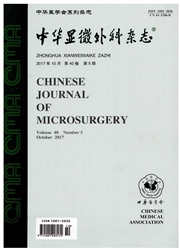

 中文摘要:
中文摘要:
目的探讨用免疫标记方法观察外周神经修复过程中许旺细胞表型改变的意义。方法用SD雄性大鼠18只,制作右侧坐骨神经损伤模型,模拟临床常见的神经外膜相对扭转的缝合方法,分别于术后1、2、3周取缝合点远近各2mm长坐骨神经标本,采用GFAP、Sox2、Krox20抗体标记许旺细胞。结果术后各观察点许旺细胞的GFAP表达均高于正常,且1周时表达最为明显;未见Sox2表达;术后1周Krox20几乎不表达,2、3周时Krox20的表达均高于正常,且Krox20阳性的许旺细胞明显增殖。结论通过免疫标记方法可以反映修复不同阶段许旺细胞的分化状态;对此现象的观察有利于判断神经再生状态并寻找影响神经再生的因素。
 英文摘要:
英文摘要:
Objective To describe the rule of the phenotypic changes of schwann cells after peripheral nerve injury. Methods All experiments were performed on 18 male SD rats. Right midseiatic nerves were cut and were repaired by epineurium suture. At selected time points after injury(lweek,2 weeks, 3weeks; n = 6 rats for each time point), the proximal and distal sciatic nerve stumps (approximately a 2 mm length of nerve to the injured tip) were removed for detecting the expressions of GFAP, Sox2 and Krox20 by immunofluorescence methods. Results After sciatic nerve transection, there was expansion in the population of GFAP-labeled Schwann cells both in the proximal and distal stumps, and those expression reached the peak near to 7 d. Sox2 was neural stem cell markers and there was no Sox2-expressed cells stumps after nerve injury. And Krox20 positive Schwann cells continuously decreased in the first week, then had increased. Conclusion The differentiated stage of Schwann cells during peripheral nerve repair can be detected by using immunolabeling, and the observation above may be beneficial to find methods in improving nerve regeneration.
 同期刊论文项目
同期刊论文项目
 同项目期刊论文
同项目期刊论文
 The Electrophysiology Analysis of Biological Conduit Sleeve Bridging Rhesus Monkey Median Nerve Inju
The Electrophysiology Analysis of Biological Conduit Sleeve Bridging Rhesus Monkey Median Nerve Inju The Influence of Brain Injury or Peripheral Nerve Injury on Calcitonin Gene-Related Peptide Concentr
The Influence of Brain Injury or Peripheral Nerve Injury on Calcitonin Gene-Related Peptide Concentr Effects of Hedysari Polysaccharides on Regeneration and Function Recovery Following Peripheral Nerve
Effects of Hedysari Polysaccharides on Regeneration and Function Recovery Following Peripheral Nerve Maximum number of collaterals developed by one axon during peripheral nerve regeneration and the inf
Maximum number of collaterals developed by one axon during peripheral nerve regeneration and the inf Alterations in the expression of ATP-sensitive potassium channel subunit mRNA after acute peripheral
Alterations in the expression of ATP-sensitive potassium channel subunit mRNA after acute peripheral Early spatiotemporal progress of myelinated nerve fiber regenerating through biological chitin condu
Early spatiotemporal progress of myelinated nerve fiber regenerating through biological chitin condu 期刊信息
期刊信息
